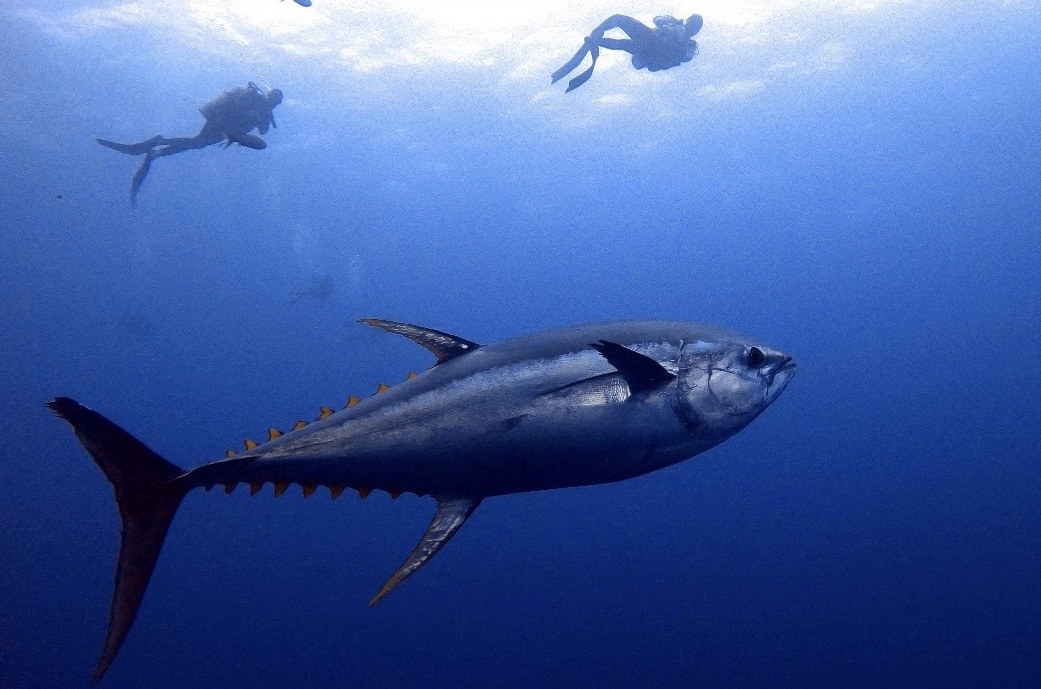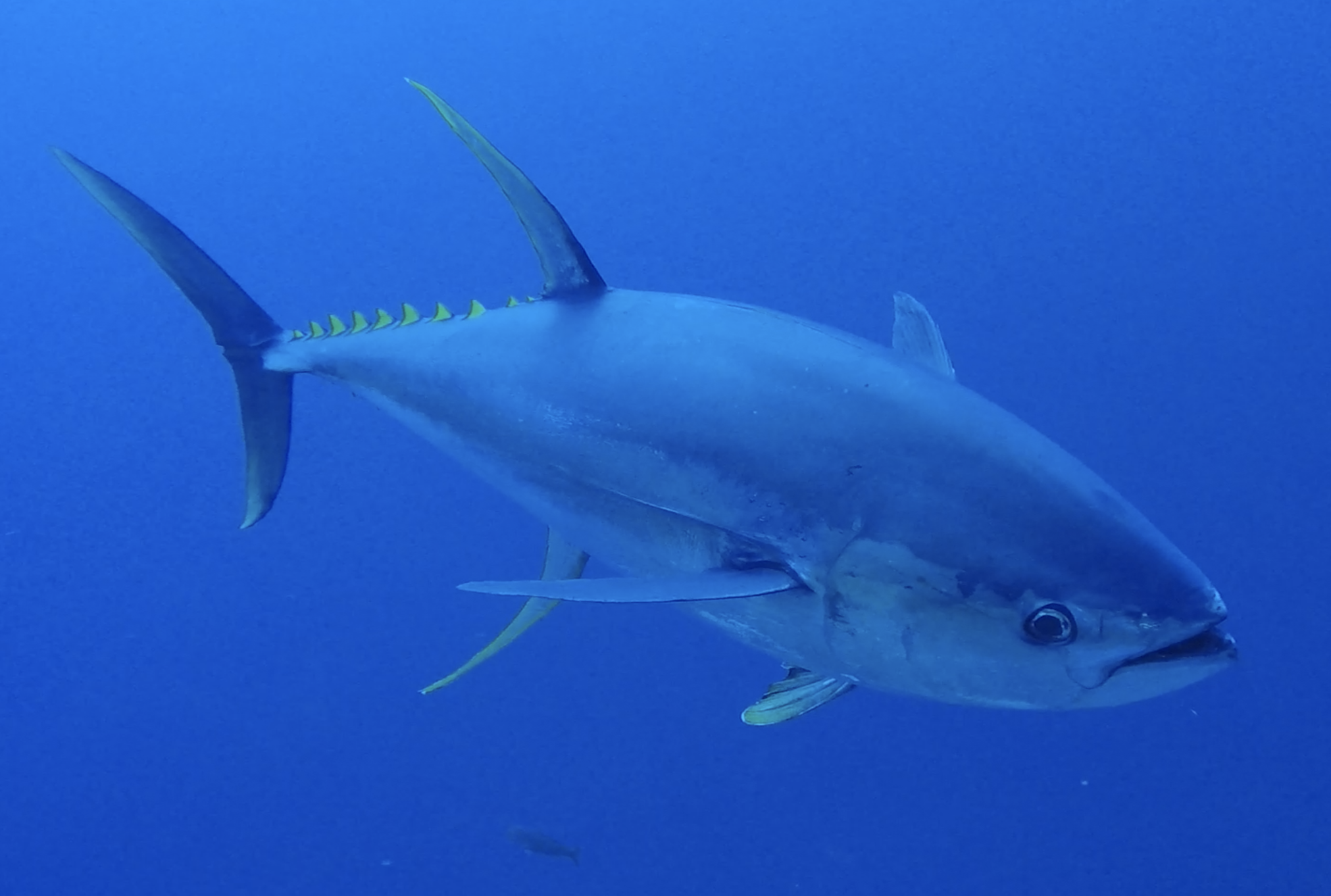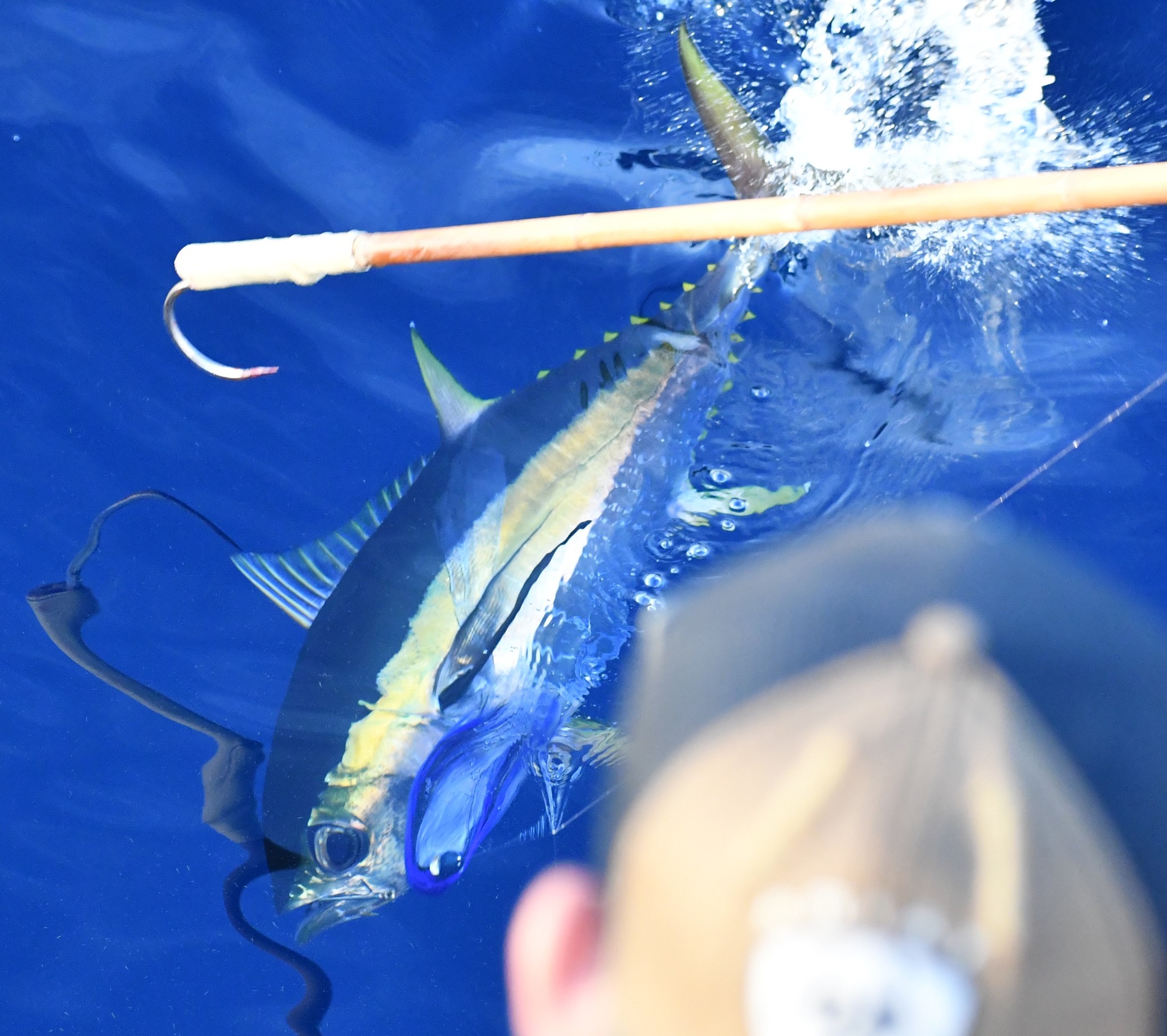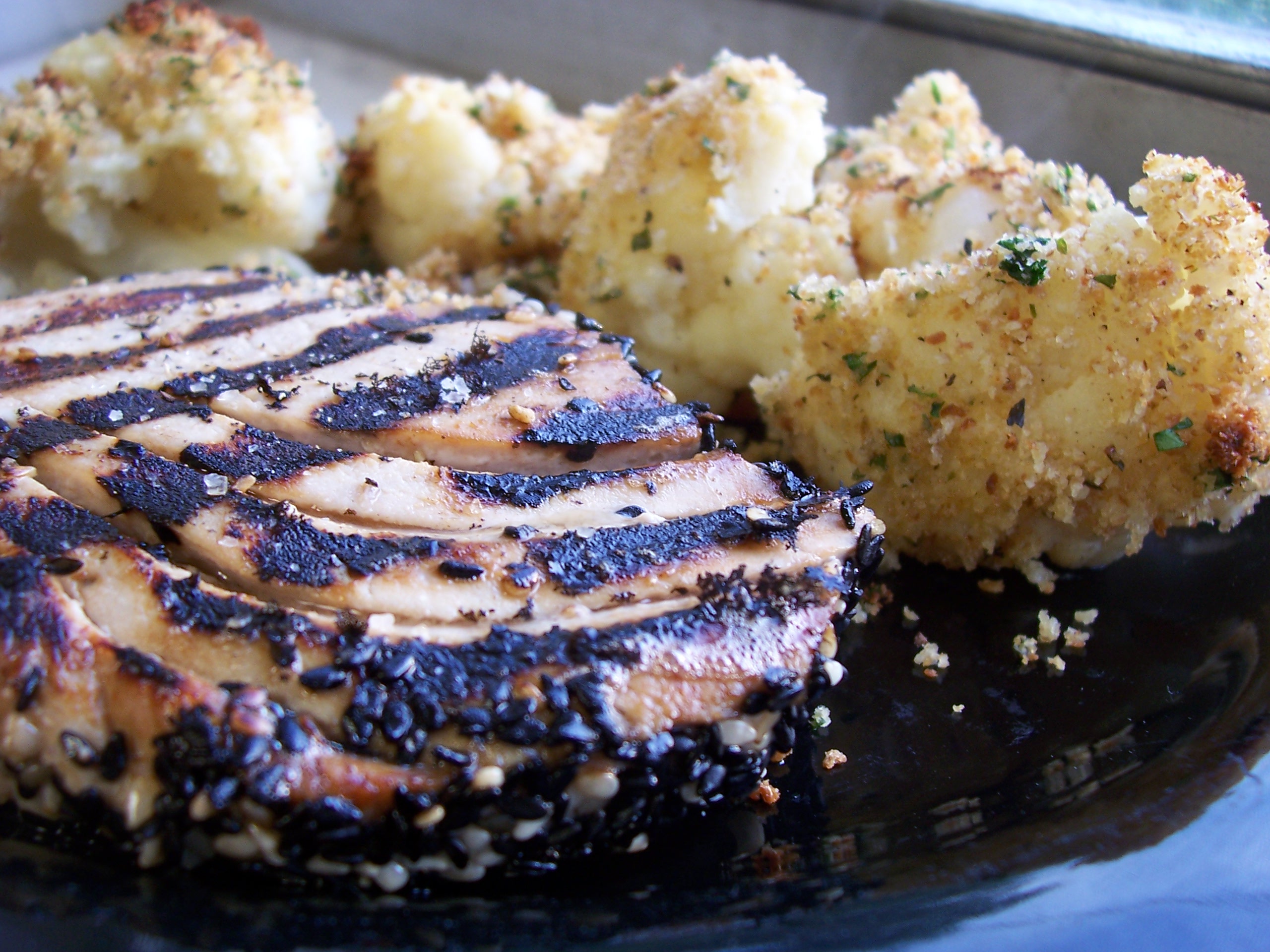Thunnus albacares
North Coast (Oregon Border to Point Arena)
North Central Coast (South of Point Arena to Half Moon Bay)
Central Coast (South of Half Moon Bay to Point Conception)
Santa Barbara (Point Conception to Point Dume)
South Coast (Point Dume to Mexico border)
Firm fish
Flakey fish
Oily fish
Wild caught

The Science

Taxonomic description
- Has a sleek torpedo-shaped body for fast movement.
- Dark blue on the back, which changes from yellow to silver down to the belly.
- Dorsal and anal fins are bright yellow giving the fish its name.
- Difficult to distinguish from other tuna species except for the elongated, sickle-shaped dorsal and anal fins found on large adults. [1]
- Can grow to be 1.8 m (6 feet) long and over 180 kg (400 lbs). [1]
Distribution
- As a highly migratory fish, yellowfin tuna is found in warm seas all over the world except the Mediterranean. [1]
- Can travel across the entire ocean basin. [1]
Life history
- Fast growing, with a somewhat short life span of 6 to 7 years. [1]
- Most yellowfin tunas are mature enough to reproduce around age 2 or 3. [1]
- Spawns at sea throughout the year in tropical waters, and from the spring–summer in cooler waters. [1]
- 24° C (75° F) is thought to be the lowest temperature limit for spawning. [1]
- Can produce two to seven million eggs per spawn. [1]
Habitat
- Travels in schools of similarly sized fish.
- Mostly found in the surface layer (≤100 m or 330 ft) of the open ocean above the thermocline, but is capable of diving over 1000 m (3300 ft). [1]
- Typically found in water temperatures between 15° – 31° C (59° - 88° F). [2]
- Known to make migratory trips to higher latitudes as the temperature of the water increases. [1]
- Gathers in areas with high productivity where smaller prey is available.
- Feeds opportunistically in open ocean on small fish, squid and invertebrates such as pelagic crabs. [1,2]
- Predators include sharks, billfish and large marine mammals.
The Fishery

Seasonal availability
- The fishery is open year-round, and is mostly recreational off San Diego in August & September.
Regulatory and managing authority
- Internationally overseen by the Inter-American Tropical Tuna Commission (IATTC) and the Western and Central Pacific Fisheries Commission (WCPFC). [1]
- Along the Pacific West Coast, the fishery is overseen by NOAA fisheries and, as established by the Magnuson-Stevens Act, the Pacific Fishery Management Council through the West Coast Highly Migratory Species Fisheries Management Plan. [10]
- As established by the Marine Life Management Act, the California Department of Fish and Wildlife (CDFW) collects data on this fishery through the Pelagic Fisheries and Ecosystems Program. [11,12]
Gear type
- Mostly caught by purse seines, but troll, hook-and-line, & pelagic longlines are also used. Hook and line is used recreationally.
Status of the fishery
- NOAA defines the population as “abundant” and fishing rate as “sustainable”. [1]
- Monterey Bay Aquarium’s “Fish Watch” lists hook-and-line tuna as “Best Choice”. [3]
- Most regulations focus on reducing the catch and mortality of non-target species.
- U.S. fishermen responsibly harvest tuna by following strict international and domestic regulations aimed at reducing fishery impacts on other species (e.g., longliners use special hooks and bait that reduce bycatch; fishers train in the safe release of non-target species; vessels are regularly monitored by scientists & managers who reassess management actions as needed). [1]
Potential ecosystem impacts
- This species is fairly resistant to fishing pressure given early maturing, high fecundity, moderate life span, & wide distribution. [4]
- Troll & hook-and-line methods have relatively low bycatch [5] whereas purse seines and long lines potentially result in moderate to high bycatch of species associated with yellowfin schools if actions are not taken to reduce bycatch and mortality rates. [1]
- Purse seiners using fish aggregating devices (FADs, manmade floating objects) to attract yellowfin must take precautions to avoid bycatch of juvenile yellowfin & non-target pelagic species.
The Seafood

Edible portions
- Usually sold as rounds, loins, or steaks.
Description of meat
- Has a mild, meaty flavor; firm texture.
- Flesh has a deep red color when raw.
Culinary uses
- Can be eaten raw or cooked, and is popular grilled or seared. [8]
- For tips on grilling tuna, visit The Spruce Eats. [8]
- For seared ahi tuna recipes, visit yummly. [9]
Nutritional information
- Raw (3 oz, 85 g). [5]
Toxicity report
- No consumption advisories are listed for troll or pole-caught yellowfin as these methods catch younger tuna with lower mercury levels. [3]
- Potential for mercury accumulation in larger tuna only (caught by seine or longline). Recommended servings that can safely be eaten per month are 4 or more for adults, 3 for kids 6-12 yr old, 3 for kids 0-5 yr old. [7]
Seasonal availability
- Yellowfin tuna is available fresh in San Diego from August–September. [6]
References
[1] FishWatch. 2013. Yellowfin Tuna. National Oceanic and Atmospheric Administration (NOAA) Fish Watch & Seafood Profiles. https://www.fishwatch.gov/profiles/pacific-yellowfin-tuna. Accessed 16 Sept 2020.
[2] Froese, R., Pauly, D., eds. 2008."Thunnus albacares" in FishBase. www.fishbase.org/summary/SpeciesSummary.php?genusname=Thunnus&speciesname=albacares. Accessed 16 Sept 2020.
[3] Seafood Watch: 2013. Yellowfin Tuna. Monterey Bay Aquarium. https://www.seafoodwatch.org/seafood-recommendations/groups/tuna?q=yellowfin&t=yellowfin&type=yellowfin. Accessed 16 Sept 2020.
[4] Morgan, A. 2014. Seafood Watch Bigeye, Skipjack, and Yellowfin Tuna Report. Monterey Bay Aquarium. https://www.seafoodwatch.org/-/m/sfw/pdf/reports/t/mba_seafoodwatch_tuna_epo_purseseine_report.pdf. Accessed 16 Sept 2020.
[5] SELF Nutrition Data: Know What You Eat. 2013. Fish, tuna, fresh, yellowfin, raw. http://nutritiondata.self.com/facts/finfish-and-shellfish-products/4150/2. Acessed 16 Sept 2020.
[6] California Dept. of Fish & Wildlife. 2013. Marine Sportfish Identification: Tunas & Mackerels. www.dfg.ca.gov/marine/mspcont1.asp. Accessed 16 Sept 2020.
[7] EDF Seafood Selector. 2013. Tuna. Environmental Defense Fund. http://seafood.edf.org/tuna. Accessed 16 Sept 2020.
[8] Riches, D.. 2013. Grilling Tuna: Rare or well you need to know the best method for grilling tuna. About.com. http://bbq.about.com/od/fishandseafood/a/aa103004a.htm. Accessed 16 Sept 2020.
[9] yummly. n.d. Seared Ahi Tuna Recipes. Web. https://www.yummly.com/recipes/seared-ahi-tuna. Accessed 4 February 2021.
[10] Fishery Management Plan for U.S. West Coast Fisheries for Highly Migratory Species. 2018. Pacific Fishery Management Council. Web. https://www.pcouncil.org/documents/2018/04/fishery-management-plan-for-w.... Accessed 24 August 2020.
[11] Marine Life Management Act. n.d. California Department of Fish and Wildlife. Web. https://wildlife.ca.gov/Conservation/Marine/MLMA. Accessed 24 August 2020.
[12] Overview of the Pelagic Fisheries and Ecosystems Program. n.d. California Department of Fish and Wildlife. Web. https://wildlife.ca.gov/Conservation/Marine/Pelagic#52132542-overview. Accessed 9 December 2020.
[13] martinmoscovich. iNaturalist. 2020. Digital image. Web. https://www.inaturalist.org/photos/83053275. Accessed 26 February 2021.
[14] Takats, B. iNaturalist. 2018. Digital image. Web. https://www.inaturalist.org/photos/77916352. Accessed 26 February 2021.
[15] McIntyre, J. iNaturalist. 2020. Digital image. Web. https://www.inaturalist.org/photos/107299049. Accessed 26 February 2021.
[16] newwavegurly. flickr. 2008. Seared yellowfin tuna steak with roasted cauliflower II. Digital image. Web. https://flickr.com/photos/87777282@N00/2561410947. Accessed 26 February 2021.
